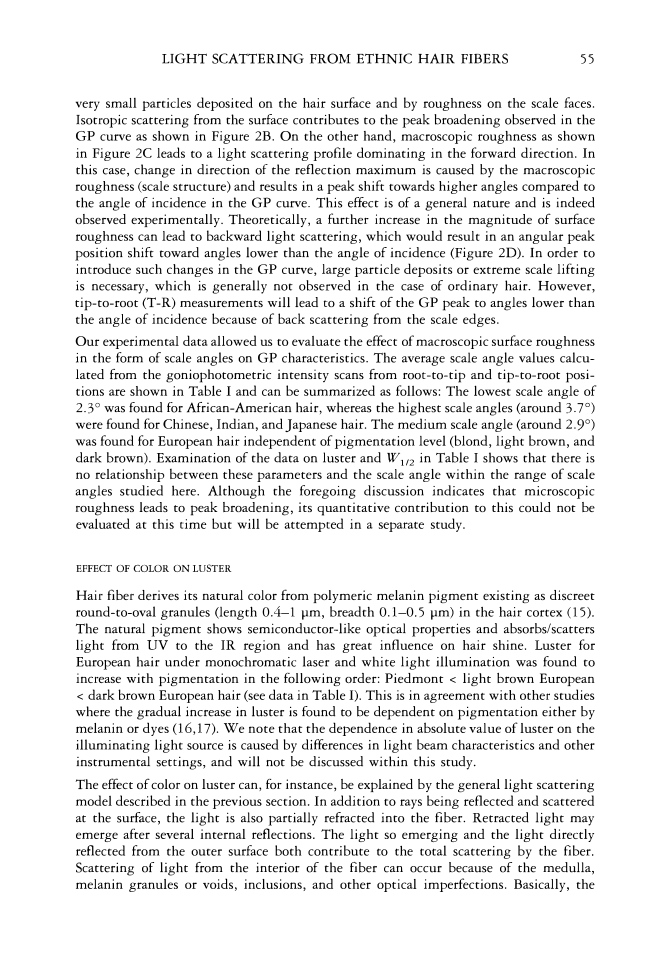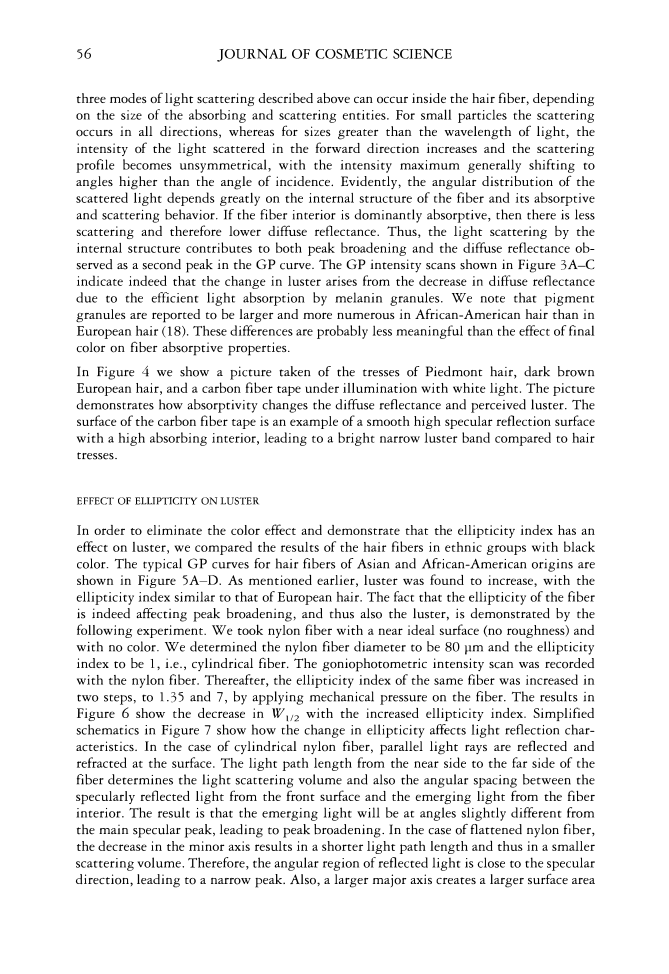LIGHT SCATTERING FROM ETHNIC HAIR FIBERS 55 very small particles deposited on the hair surface and by roughness on the scale faces. Isotropic scattering from the surface contributes to the peak broadening observed in the GP curve as shown in Figure 2B. On the other hand, macroscopic roughness as shown in Figure 2C leads to a light scattering profile dominating in the forward direction. In this case, change in direction of the reflection maximum is caused by the macroscopic roughness (scale structure) and results in a peak shift towards higher angles compared to the angle of incidence in the GP curve. This effect is of a general nature and is indeed observed experimentally. Theoretically, a further increase in the magnitude of surface roughness can lead to backward light scattering, which would result in an angular peak position shift toward angles lower than the angle of incidence (Figure 2D). In order to introduce such changes in the GP curve, large particle deposits or extreme scale lifting is necessary, which is generally not observed in the case of ordinary hair. However, tip-to-root (T-R) measurements will lead to a shift of the GP peak to angles lower than the angle of incidence because of back scattering from the scale edges. Our experimental data allowed us to evaluate the effect of macroscopic surface roughness in the form of scale angles on GP characteristics. The average scale angle values calcu lated from the goniophotometric intensity scans from root-to-tip and tip-to-root posi tions are shown in Table I and can be summarized as follows: The lowest scale angle of 2.3° was found for African-American hair, whereas the highest scale angles (around 3.7°) were found for Chinese, Indian, and Japanese hair. The medium scale angle (around 2.9 ° ) was found for European hair independent of pigmentation level (blond, light brown, and dark brown). Examination of the data on luster and W112 in Table I shows that there is no relationship between these parameters and the scale angle within the range of scale angles studied here. Although the foregoing discussion indicates that microscopic roughness leads to peak broadening, its quantitative contribution to this could not be evaluated at this time but will be attempted in a separate study. EFFECT OF COLOR ON LUSTER Hair fiber derives its natural color from polymeric melanin pigment existing as discreet round-to-oval granules (length 0.4-1 µm, breadth 0.1-0.5 µm) in the hair cortex (15). The natural pigment shows semiconductor-like optical properties and absorbs/scatters light from UV to the IR region and has great influence on hair shine. Luster for European hair under monochromatic laser and white light illumination was found to increase with pigmentation in the following order: Piedmont light brown European dark brown European hair (see data in Table I). This is in agreement with other studies where the gradual increase in luster is found to be dependent on pigmentation either by melanin or dyes (16,17). We note that the dependence in absolute value of luster on the illuminating light source is caused by differences in light beam characteristics and other instrumental settings, and will not be discussed within this study. The effect of color on luster can, for instance, be explained by the general light scattering model described in the previous section. In addition to rays being reflected and scattered at the surface, the light is also partially refracted into the fiber. Retracted light may emerge after several internal reflections. The light so emerging and the light directly reflected from the outer surface both contribute to the total scattering by the fiber. Scattering of light from the interior of the fiber can occur because of the medulla, melanin granules or voids, inclusions, and other optical imperfections. Basically, the
56 JOURNAL OF COSMETIC SCIENCE three modes of light scattering described above can occur inside the hair fiber, depending on the size of the absorbing and scattering entities. For small particles the scattering occurs in all directions, whereas for sizes greater than the wavelength of light, the intensity of the light scattered in the forward direction increases and the scattering profile becomes unsymmetrical, with the intensity maximum generally shifting to angles higher than the angle of incidence. Evidently, the angular distribution of the scattered light depends greatly on the internal structure of the fiber and its absorptive and scattering behavior. If the fiber interior is dominantly absorptive, then there is less scattering and therefore lower diffuse reflectance. Thus, the light scattering by the internal structure contributes to both peak broadening and the diffuse reflectance ob served as a second peak in the GP curve. The GP intensity scans shown in Figure 3A-C indicate indeed that the change in luster arises from the decrease in diffuse reflectance due to the efficient light absorption by melanin granules. We note that pigment granules are reported to be larger and more numerous in African-American hair than in European hair (18). These differences are probably less meaningful than the effect of final color on fiber absorptive properties. In Figure 4 we show a picture taken of the tresses of Piedmont hair, dark brown European hair, and a carbon fiber tape under illumination with white light. The picture demonstrates how absorptivity changes the diffuse reflectance and perceived luster. The surface of the carbon fiber tape is an example of a smooth high specular reflection surface with a high absorbing interior, leading to a bright narrow luster band compared to hair tresses. EFFECT OF ELLIPTICITY ON LUSTER In order to eliminate the color effect and demonstrate that the ellipticity index has an effect on luster, we compared the results of the hair fibers in ethnic groups with black color. The typical GP curves for hair fibers of Asian and African-American origins are shown in Figure SA-D. As mentioned earlier, luster was found to increase, with the ellipticity index similar to that of European hair. The fact that the ellipticity of the fiber is indeed affecting peak broadening, and thus also the luster, is demonstrated by the following experiment. We took nylon fiber with a near ideal surface (no roughness) and with no color. We determined the nylon fiber diameter to be 80 µm and the ellipticity index to be 1, i.e., cylindrical fiber. The goniophotometric intensity scan was recorded with the nylon fiber. Thereafter, the ellipticity index of the same fiber was increased in two steps, to 1.35 and 7, by applying mechanical pressure on the fiber. The results in Figure 6 show the decrease in W 112 with the increased ellipticity index. Simplified schematics in Figure 7 show how the change in ellipticity affects light reflection char acteristics. In the case of cylindrical nylon fiber, parallel light rays are reflected and refracted at the surface. The light path length from the near side to the far side of the fiber determines the light scattering volume and also the angular spacing between the specularly reflected light from the front surface and the emerging light from the fiber interior. The result is that the emerging light will be at angles slightly different from the main specular peak, leading to peak broadening. In the case of flattened nylon fiber, the decrease in the minor axis results in a shorter light path length and thus in a smaller scattering volume. Therefore, the angular region of reflected light is close to the specular direction, leading to a narrow peak. Also, a larger major axis creates a larger surface area
Purchased for the exclusive use of nofirst nolast (unknown) From: SCC Media Library & Resource Center (library.scconline.org)





































































































































